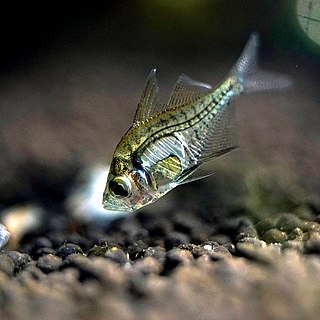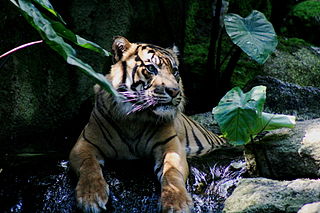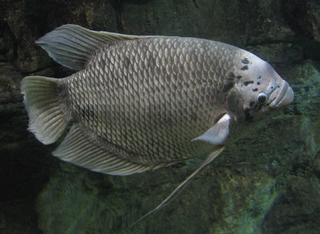
Gouramis, or gouramies, are a group of freshwater anabantiform fish that comprise the family Osphronemidae. The fish are native to Asia—from the Indian Subcontinent to Southeast Asia and northeasterly towards Korea. The name "gourami", of Indonesian origin, is also used for fish of the families Helostomatidae and Anabantidae.

Wallacea is a biogeographical designation for a group of mainly Indonesian islands separated by deep-water straits from the Asian and Australian continental shelves. Wallacea includes Sulawesi, the largest island in the group, as well as Lombok, Sumbawa, Flores, Sumba, Timor, Halmahera, Buru, Seram, and many smaller islands. The islands of Wallacea lie between the Sunda Shelf to the west, and the Sahul Shelf including Australia and New Guinea to the south and east. The total land area of Wallacea is 347,000 km2 (134,000 sq mi).

The clown loach, or tiger botia, is a tropical freshwater fish belonging to the botiid loach family. It is the sole member of the genus Chromobotia. It originates in inland waters in Indonesia on the islands of Sumatra and Borneo. In Sentarum, West Borneo that fish named: ulanguli. It is a popular fish in the freshwater aquarium trade and is sold worldwide.

The Asiatic glassfishes are a family, the Ambassidae, of freshwater and marine ray-finned fishes that were formerly classified in the order Perciformes, but most authorities consider this order to be paraphyletic and that the Ambassidae are of uncertain affinities, incertae sedis, but within the subseries Ovalentaria. The species in the family are native to Asia, Oceania, the Indian Ocean, and the western Pacific Ocean. The family includes eight genera and about 51 species. Some species are known as perchlets.

Parambassis is a genus of freshwater fish in the Asiatic glassfish family Ambassidae of order Perciformes. The type species is the Iridescent glassy perchlet. These fishes originate mostly from Southeast Asia, but the species range across the Indomalayan and Australasian realms, from Pakistan, China and India south through Indonesia, New Guinea and Australia. Although primiarly found in fresh water, a few species can also be seen in brackish water. The Parambassis species range in maximum size from 4–24 cm (1.5–9.5 in), but they are similar in appearance, with a lozenge-shaped form, typical perciform fins, and semitransparent or transparent body. Several of the species are common food fish in local markets, and some are kept as aquarium fish.

The Kapuas River is a river in the Indonesian part of Borneo island, at the geographic center of Maritime Southeast Asia. At 1,143 kilometers (710 mi) in length, it is the longest river in the island of Borneo and the longest river in Indonesia and one of the world's longest island rivers. It originates in the Müller mountain range at the center of the island and flows west into the South China Sea creating an extended marshy delta. The delta is located west-southwest of Pontianak, the capital of the West Kalimantan province. This Kapuas River should be distinguished from another Kapuas River, which starts on the other side of the same mountain range in central Borneo but flows to the south, merging with the Barito River and discharging into the Java Sea.

Rasbora is a genus of fish in the family Cyprinidae. They are native to freshwater habitats in South and Southeast Asia, as well as southeast China. A single species, R. gerlachi, is only known from an old specimen that reputedly originated from Africa (Cameroon), but this locality is considered doubtful. They are small, up to 17 cm (6.7 in) long, although most species do not surpass 10 cm (4 in) and many have a dark horizontal stripe.

Freshwater swamp forests, or flooded forests, are forests which are inundated with freshwater, either permanently or seasonally. They normally occur along the lower reaches of rivers and around freshwater lakes. Freshwater swamp forests are found in a range of climate zones, from boreal through temperate and subtropical to tropical.

The fauna of Indonesia is characterised by high levels of biodiversity and endemicity due to its distribution over a vast tropical archipelago. Indonesia divides into two ecological regions; western Indonesia which is more influenced by Asian fauna, and the east which is more influenced by Australasian species.

Osphronemus is a genus of large gouramis, the only genus within the subfamily Osphroneminae. These fish are known as the giant gouramis and are native to rivers, lakes, pools, swamps and floodplains in Southeast Asia, with O. exodon from the Mekong basin, O. laticlavius and O. septemfasciatus from Borneo, while O. goramy is relatively widespread. O. goramy has been introduced outside its native range in Asia, Africa and Australia.

Pectenocypris is a genus of small fish in the family Cyprinidae endemic to freshwater habitats in Borneo and Sumatra in Indonesia.
Gymnochanda is a genus of ray-finned fishes in the family Ambassidae, the Asiatic glassfishes. They are native to turbid fresh water habitats near peat or swamp forests in Peninsular Malaysia, Borneo, Sumatra and Belitung Island.
Tyson Royal Roberts is an American ichthyologist. He has been described as "the world's foremost authority on Regalecus".

The longfin snake-eel is an eel in the family Ophichthidae. It was described by John Richardson in 1848. It has a Dorsal fin beginning above its pectoral fin with a snake-like upper body which is cylindrical, but compressed only along its extreme tail tip. It also has a tubular nostril in front and a nostril along lower edge of the lip in back. Colors range from grey to black to brown. Large longfin snake-eels have wrinkled skin.

Datnioides microlepis, also known as the Indonesian tiger perch, Indo datmoid, Indonesian tigerfish, or finescale tigerfish, is a species of freshwater ray-finned fish belonging to the family Lobotidae, the tripletails and tiger perches. This species is endemic to the islands of Sumatra and Kalimantan in Indonesia.

Tor douronensis, also known as Labeobarbus douronensis, is a species of ray-finned fish of the family Cyprinidae in the genus Tor. This Asian fresh water river carp can be discovered in southern Thailand, east to Vietnam and south to Indonesia. The species is known from the Chao Phraya and Mekong rivers.
This fish has been attributed to Valenciennes however, in his original notes, he claims that the fish he described "formed part of the collection made in Java by Kuhl and Van Hesselt; they named it Dourr." Certainly, the type locality is Java, in Indonesia and the holotype is lodged at Bogor Zoology Museum.

The giant gourami is a species of large gourami native to freshwater habitats in Southeast Asia. It has also been introduced elsewhere. The species is commercially important as a food fish and is also farmed. It can be found in the aquarium trade, as well. The species has been used for weed control on highly invasive aquatic plants like Salvinia molesta, as the giant gourami can be a voracious herbivore.

Achiroides melanorhynchus is a species of sole native to Southeast Asia. It was first described by Pieter Bleeker in 1850.
Lepidocephalus spectrum is a species of fish in the family Cobitidae. It lacks eyes and pigmentation, similar to cavefishes, but is endemic to the Kapuas River basin of Borneo.














